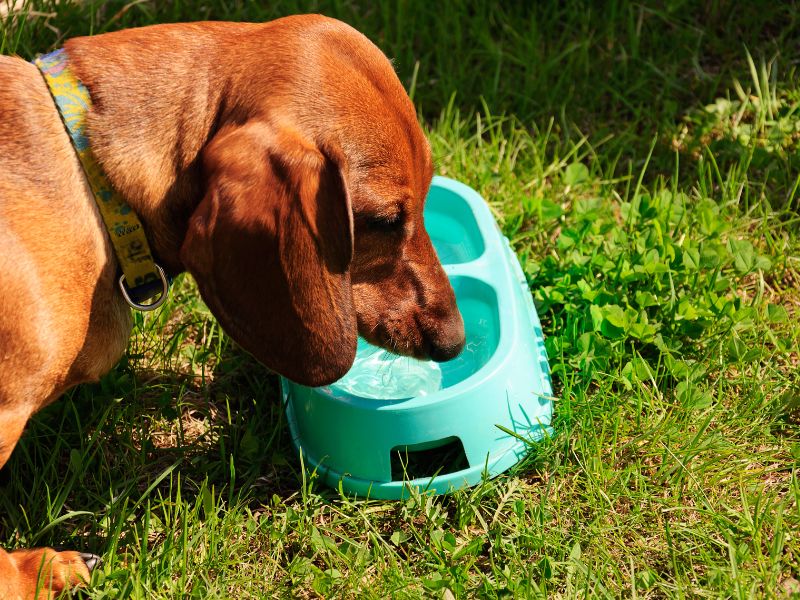Dog Chocolate Toxicity Calculator: Instant Results
Protect your pet with HolistaPet's Dog Chocolate Toxicity Calculator. If your dog accidentally eats chocolate, this tool provides an accurate toxicity assessment based on your pet's weight, the amount of chocolate consumed, and any symptoms.
Take the guesswork out of a stressful situation and get peace of mind with actionable insights tailored to your furry friend.
How Holistapet’s Dog Chocolate Calculator Works
Our Dog Chocolate Toxicity Calculator is designed to be simple and reliable. Here's how to use it:
1. Input Your Dog's Weight
Enter your dog's weight in pounds or kilograms. Weight is critical in determining how much theobromine their system can handle.
2. Enter the Type and Amount of Chocolate Consumed
Different chocolates have varying levels of theobromine and caffeine. For example, dark chocolate is far more toxic than milk chocolate. The tool calculates toxicity levels based on the type and quantity your dog ingested.
3. Describe Symptoms (if any)
To get a comprehensive risk evaluation, include signs like vomiting, diarrhea, restlessness, or tremors.
4. Receive Results and Recommendations
The calculator instantly provides an assessment, helping you decide whether veterinary care is needed or if monitoring at home is sufficient.

Why Is Chocolate Bad for Dogs?
Chocolate may be a beloved treat for humans, but it contains two compounds—theobromine and caffeine—highly toxic to dogs.
These naturally occurring substances, found in cocoa beans, affect a dog's central nervous and cardiovascular systems, leading to symptoms ranging from mild discomfort to life-threatening conditions.

Theobromine: The Main Culprit in Chocolate Toxicity
Theobromine is the primary toxic compound in chocolate that poses a danger to dogs. It belongs to a group of chemicals called methylxanthines, which affect the central nervous and cardiovascular systems.
While humans can metabolize theobromine rapidly, dogs process it much more slowly, causing it to accumulate in their bodies and reach toxic levels.
Key Facts About Theobromine:
- Effects on Dogs: Theobromine overstimulates the central nervous system and increases heart rate. In severe cases, theobromine may lead to tremors, seizures, or even heart failure.
- Duration in the Body: Theobromine can remain in a dog's system for up to 17 hours, leading to prolonged toxic effects.
- Concentration in Chocolate: Dark chocolate and baking chocolate have the highest theobromine levels, while white chocolate contains negligible amounts.
- Toxic Dose: As little as 20 mg of theobromine/kilogram of body weight can cause mild symptoms, while 100–200 mg/kg can be fatal.

What to Do If Your Dog Ate Chocolate
If your dog has eaten chocolate, it's important to act quickly and make informed decisions to protect their health. While some cases may only require monitoring, others can lead to severe symptoms that need immediate veterinary attention.
Below, we outline how to respond in different scenarios to ensure your furry friend gets the care they need.
Dog Chocolate Calculator
Caffeine: The Secondary Danger in Chocolate
Caffeine: The Secondary Danger in Chocolate
Caffeine, another methylxanthine found in chocolate, is less concentrated than theobromine but poses a significant risk to dogs.
Its effects on the body are similar to theobromine's, as it overstimulates the central nervous and cardiovascular systems.
Key Facts About Caffeine:
- Effects on Dogs: Caffeine heightens alertness, increases heart rate, and can lead to restlessness, hyperactivity, and muscle tremors. In severe cases, seizures or collapse may occur.
- Synergistic Effect: When combined with theobromine, caffeine amplifies the toxic effects, making chocolate ingestion even more dangerous for dogs.
- Sources Beyond Chocolate: While chocolate is a major source, caffeine is also found in coffee, tea, energy drinks, and some medications, all of which should be kept away from pets.
- Toxic Dose: Mild symptoms can appear at doses as low as 10–20 mg of caffeine per kilogram of body weight, with severe toxicity occurring at higher levels.
How Theobromine and Caffeine Work Together
How Theobromine and Caffeine Work Together
When a dog ingests chocolate, the combination of theobromine and caffeine creates a compounded effect:
- Both compounds stimulate the nervous system, causing hyperactivity, restlessness, and tremors.
- They also increase heart rate, which can lead to heart failure or arrhythmias in severe cases.
- The slow metabolism of these substances in dogs prolongs their effects, increasing the risk of complications.
Understanding these toxic compounds highlights why even small amounts of chocolate can harm dogs. Always keep chocolate and other sources of methylxanthines out of reach of your pets.
Foods Highest in Theobromine: Common Form Factors and Measurements
Foods Highest in Theobromine: Common Form Factors and Measurements
| Food | Common Form Factor | Serving Size | Theobromine (mg) | Theobromine per Gram (mg/g) |
|---|---|---|---|---|
| Cocoa, dry powder, unsweetened, processed with alkali (Dutch cocoa) | 1 cup (86g) | 86g | 2266 mg | 26.3 mg/g |
| Baking chocolate, unsweetened, squares | 1 cup, grated (132g) | 132g | 1712 mg | 13.0 mg/g |
| Dark chocolate (70-85% cacao) | 1 bar (100g) | 100g | 802–1000 mg | 8.0–10.0 mg/g |
| Milk chocolate | 1 bar (100g) | 100g | 154–211 mg | 1.5–2.1 mg/g |
| White chocolate | 1 bar (100g) | 100g | <2 mg | <0.02 mg/g |
| Cocoa nibs | 1 oz (28g) | 28g | 336 mg | 12.0 mg/g |
| Hot cocoa (prepared with water, unsweetened) | 1 cup (240ml) | 240ml | 40–60 mg | ~0.2 mg/ml |
| Chocolate syrup | 1 tablespoon (19g) | 19g | 5–11 mg | 0.3–0.6 mg/g |
| Chocolate ice cream | 1 cup (132g) | 132g | 10–30 mg | 0.08–0.2 mg/g |
| Chocolate cake (prepared, unfrosted) | 1 slice (64g) | 64g | 20–40 mg | 0.3–0.6 mg/g |
| Chocolate pudding | 1/2 cup (110g) | 110g | 15–40 mg | 0.1–0.4 mg/g |
| Cacao tea (brewed from husks) | 1 cup (240ml) | 240ml | 15–30 mg | ~0.1 mg/ml |
| Chocolate-flavored cereal | 1 cup (55g) | 55g | 20–50 mg | 0.4–0.9 mg/g |
Key Takeaways:
- Highest Risk Foods for Dogs: Unsweetened cocoa powder, baking chocolates, and dark chocolates are the most dangerous due to their high theobromine concentration.
- Lowest Risk Foods for Dogs: White chocolate and cocoa butter have negligible theobromine content but can cause issues due to their fat and sugar content.
- Consumption in Humans: These foods are safe for humans but should always be kept out of reach of pets.
My Dog Ate Chocolate: What Do I Do?
My Dog Ate Chocolate: What Do I Do?
- Use the dog chocolate toxicity calculator to assess the situation.
- Monitor for symptoms like vomiting, diarrhea, or hyperactivity.
- Contact your veterinarian if symptoms become severe or if a large amount of chocolate is consumed.
Try the HolistaPet “How Much Chocolate Will Hurt a Dog” Calculator
Try the HolistaPet “How Much Chocolate Will Hurt a Dog” Calculator
This tool is your first line of defense when accidents happen. It provides quick, reliable information to help you determine the next steps for your pet's care.
What to Do If a Dog Eats Chocolate but Is Acting Fine
What to Do If a Dog Eats Chocolate but Is Acting Fine
Even if your dog seems unaffected, toxic effects can take 6+ hours to manifest. Use the calculator to estimate risk based on the type and amount of chocolate consumed. Watch for delayed symptoms and seek veterinary care if necessary.
Symptoms of Chocolate Poisoning in Dogs + Timeline
Recognizing symptoms of chocolate poisoning is essential for prompt intervention and treatment. These symptoms reflect how a dog's body responds to the toxic effects of chocolate.
The symptoms can progress quickly from mild to severe. Symptoms will depend on the amount consumed and the dog's size and sensitivity.
Mild Symptoms
Mild Symptoms
Mild symptoms typically occur when a dog consumes a small amount of chocolate or a lower-theobromine product like milk chocolate. These signs may not seem alarming at first, but should not be ignored:
- Restlessness or Hyperactivity: Your dog may appear unusually alert, pacing, or unable to relax.
- Increased Thirst and Urination: Theobromine acts as a diuretic, causing your dog to drink and urinate more frequently.
- Digestive Upset: Vomiting and diarrhea are common as the digestive system reacts to the toxins.
Moderate Symptoms
Moderate Symptoms
As toxicity levels increase, symptoms can intensify, signaling that your dog's body is under more stress:
- Elevated Heart Rate: When resting, you may notice your dog's heartbeat is faster or irregular.
- Panting or Rapid Breathing: Difficulty breathing may occur if the cardiovascular system becomes overstimulated.
- Tremors or Muscle Twitching: These involuntary movements indicate that the central nervous system is affected.
Severe Symptoms
Severe Symptoms
Severe symptoms of chocolate poisoning are life-threatening and require immediate veterinary attention. These include:
- Seizures Sudden, uncontrolled muscle activity is a critical indicator of severe toxicity.
- Collapse or Weakness: Your dog may lose energy or the ability to stand, signaling major cardiovascular or neurological distress.
- Irregular Heart Rhythms: Dangerous arrhythmias can lead to heart failure if left untreated.
Progression of Symptoms
Progression of Symptoms
- Onset Time: : Symptoms often begin within 6–12 hours of ingestion but can take up to 24 hours in some cases.
- Duration: Difficulty breathing The effects of chocolate poisoning can last for 1–3 days due to the slow metabolism of theobromine in dogs.
When to Seek Veterinary Care
When to Seek Veterinary Care
If your dog exhibits any of these symptoms or if you suspect they've consumed chocolate, contact your emergency vet or call the Pet Poison Helpline (1-855-764-7661) immediately. Severe cases may require intravenous fluids, hospitalization, and other treatments to stabilize your dog's condition. Early treatment is the best way to prevent severe outcomes.
FAQs About Chocolate Toxicity in Dogs
Will My Dog Be OK If She Ate a Little Chocolate?
Will My Dog Be OK If She Ate a Little Chocolate?
For most dogs, consuming a small amount of chocolate is unlikely to cause severe harm. Approximately 80–90% of dogs that ingest less than 20 mg of theobromine to kg of body weight experience only mild symptoms like stomach upset.
Larger dog breeds can tolerate small amounts better than smaller breeds, but monitoring for symptoms like vomiting or restlessness is essential. Use a dog chocolate toxicity calculator to assess the risk and confirm safety. Always contact your veterinarian if you're unsure.
Will One Chocolate Chip or M&M Hurt a Dog?
Will One Chocolate Chip or M&M Hurt a Dog?
For most dogs, eating one chocolate chip or M&M is not toxic. A single chocolate chip contains about 0.1–0.5 mg of theobromine, far below the toxic threshold of 20 mg/kilogram of body weight for mild symptoms.
However, even tiny amounts can cause stomach upset or mild hyperactivity in puppies or small breeds. While serious toxicity is unlikely, it's always wise to monitor your dog and ask a vet free if you have concerns.
Will a Small Amount of White Chocolate Hurt My Dog?
Will a Small Amount of White Chocolate Hurt My Dog?
A small amount of white chocolate is unlikely to harm your dog. White chocolate contains negligible levels of theobromine (less than 0.1 mg per gram), far below toxic thresholds.
However, the high sugar and fat content may cause mild stomach upset or, in rare cases, trigger pancreatitis in sensitive dogs.
While white chocolate is not a major toxicity risk, keeping it away from your pet is still best to avoid digestive issues.
How Long After a Dog Eats Chocolate Will They Be OK?
How Long After a Dog Eats Chocolate Will They Be OK?
About 75% of dogs with chocolate toxicity show symptoms within 6–12 hours after ingestion. If no symptoms appear within 12–24 hours, the risk of severe poisoning decreases, but monitoring is still essential for delayed signs.
Mild cases typically resolve within 24–48 hours, while severe cases may require prolonged care. Always consult a veterinarian for guidance.
Can a Dog Survive Chocolate Poisoning Without Treatment?
Can a Dog Survive Chocolate Poisoning Without Treatment?
Yes, dogs may survive mild cases of chocolate poisoning without treatment. Still, severe cases can be life-threatening and require immediate veterinary care to prevent complications like seizures, heart failure, or death.
Always consult a vet if your dog has consumed chocolate.

Home Treatment for Chocolate Poisoning in Dogs
Taking swift action at home can sometimes prevent more serious complications. While licensed veterinary care is essential for severe cases, here are steps you can take at home for mild cases or as a first response.
Below, we outline practical home treatment options to help minimize the effects of chocolate poisoning.

How Can I Treat My Dog at Home After Eating Chocolate?
If your dog has consumed chocolate, taking the right steps may help reduce the risk of toxicity. Home treatments are appropriate only for mild cases or when recommended by a veterinarian.
Follow these steps:
- Assess the Risk: Use Holistapet's Dog Chocolate Toxicity Calculator to estimate the danger based on your dog's weight, the type of chocolate, and the quantity consumed.
- Call Your Veterinarian: Always consult a vet before attempting any treatment at home. They will determine whether immediate care or monitoring is necessary.
- (if advised by your vet) Induce vomiting: If ingestion occurred within the last hour, your vet may instruct you to give 3% hydrogen peroxide (1 tsp/10 pounds of body weight) to help your dog expel the chocolate.
- Limit Activity: Keep your dog in a calm area and avoid physical activity, which can worsen symptoms such as elevated heart rate or restlessness.
- Monitor for Symptoms: Mild cases may only involve vomiting, diarrhea, or hyperactivity. If symptoms worsen, seek veterinary care immediately.
These steps are best suited for mild cases. Severe cases or large chocolate consumption require professional intervention.

How to Flush Chocolate Out of a Dog’s System?
Flushing chocolate out of your dog's system involves both managing the toxins and supporting their elimination. This approach is more focused on detoxification and requires veterinary guidance.
- Induce Vomiting: If ingestion occurred within 1–2 hours, your veterinarian might recommend inducing vomiting using 3% hydrogen peroxide. The hydrogen peroxide may effectively remove chocolate from the stomach before absorption.
- Administer Activated Charcoal: A veterinarian may provide activated charcoal to bind theobromine and caffeine in the digestive system, preventing further absorption.
- Encourage Hydration: Offer small amounts of water(sips every 15-30 minutes) to support kidney function and help flush theobromine through urine. Be cautious not to overhydrate your dog.
- Provide Supportive Care: If symptoms like restlessness or vomiting persist, a vet may recommend treatments such as intravenous fluids or medications to stabilize your dog.
Flushing chocolate from your dog's system is most effective under veterinary supervision, especially if large amounts of chocolate are consumed. Avoid attempting these steps without professional advice.
Protect Your Dog with HolistaPet’s Dog Chocolate Toxicity Calculator
Chocolate toxicity can be a life-threatening issue for dogs. With HolistaPet's Dog Chocolate Toxicity Calculator, you have the tools to act quickly and confidently.
Help protect other pets! Share this page with fellow pet owners to raise awareness.

